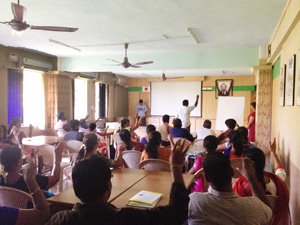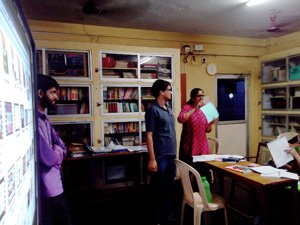You Can Do It, South India!
The Japan Foundation, New Delhi (South India)
OGAWA Kyoko
1. Shifting Office of Operations in South India
The dispatch of Japanese-Language Specialists to the South India began with the office of operations moving from Bangalore (Bangalore University) to Hyderabad (English and Foreign Languages University, Hyderabad), back to Bangalore (Bangalore Nihongo Kyooshikai), and finally to Chennai (ABK-AOTS DOSOKAI, Tamil Nadu Center). I took my position as the first Japanese-Language Specialist at Chennai in May 2014 and remained there for three years until May 2017.
The number of Japanese-Language Assistants rose in April of this year, with one each assigned to work with a Japanese-Language Senior Specialist, and this has allowed us to handle much that we previously had been unable to do, giving us something to look forward to.
2. Brush-up Course to Improve Japanese and Teaching Capabilities
The purpose of dispatching Japanese-Language Specialists to South India is to both expand and increase the quality of Japanese-language education. To date, many approaches have been tried, including a 1-week intensive Japanese-language teacher training course nation-wide, 2-day weekend workshops, mini-workshops designed by each Regional Japanese-Language Specialist to match the local situation, and brush-up courses.
Of those, Chennai has been running its own Brush-up Course in which aspiring and current teachers practice Japanese while working to increase their teaching skills. The course, which began in January 2016, provides an opportunity for take time learning, including pronunciation, Hiragana, Katakana, the use of picture cards, how to do basic and applied practice, approaches to conversation, preparing for classes, and course design methods, all while reviewing basic Japanese. Students also learned through practice about how to study on their own and the benefits of doing so.
3. Participants Beginning to Teach
Almost all of the aspiring teachers began teaching in July, just six months after the course began.

Students use air writing to practice calligraphy fundamentals including stroke order, stops, sweeps, and upward strokes.
One teacher who recently began teaching writing to a class of 60 at university reported that after they adopted what they learned in the brush-up course, their students were able to write Hiragana correctly.
There are even those who were put in charge of teacher training for new teachers at their school by December, one year later. Those teachers include one who was only a beginner when I took over three years ago, while another had not even begun studying Japanese yet.

Japanese-language teacher training course for developing junior teachers
Teachers who attended the same class go on to exchange class ideas and teaching materials in an effort to make their classes more interesting. I myself have much to learn from them because they expertly adopt techniques that are effective when teaching Indian learners that we Japanese teachers are unlikely to pick up on.
4. The South India Network
After being assigned to my post, I established two groups on Facebook (hereinafter “FB”) called the “South India Japanese Language Teachers Network" and the "JF South India Japanese Learners Network." The teachers have commented that these networks have brought the wider region of South India together. There are also Japanese volunteers who are involved with supporting classes at Japanese-language educational institutions and supporting study and exchange meets with the teachers.
I recall countless fun memories as I read through these FB groups.
There is everyone at the ABK-AOTS Tamil Nadu Center who provided the office, the teachers who were always so kind to me, and the new teachers who grew from learners to teachers. One of my goals was for Indian teachers to grow enough to train new teachers, and I look forward to seeing them train the future generations of teachers.
You can do it, South India!
- What We Do Top
- Arts and Cultural Exchange [Culture]
- Japanese-Language Education Overseas [Language]
- Japanese-Language Education Overseas [Language] Top
- Learn Japanese-language
- Teach Japanese-language
- Take Japanese-Language Test
- Know about Japanese-language education abroad
- The Japanese-Language Institute, Urawa
- The Japanese-Language Institute, Kansai
- Japanese-Language Programs for Foreign Specified Skilled Worker Candidates
- Japanese Language Education for Japanese Children Resident Overseas and for the Descendants of Migrants
- Archives
- Japanese Studies and Global Partnerships [Dialogue]
- JF digital collection
- Other Programs / Programs to Commemorate Exchange Year
- Awards and Prizes
- Publications
